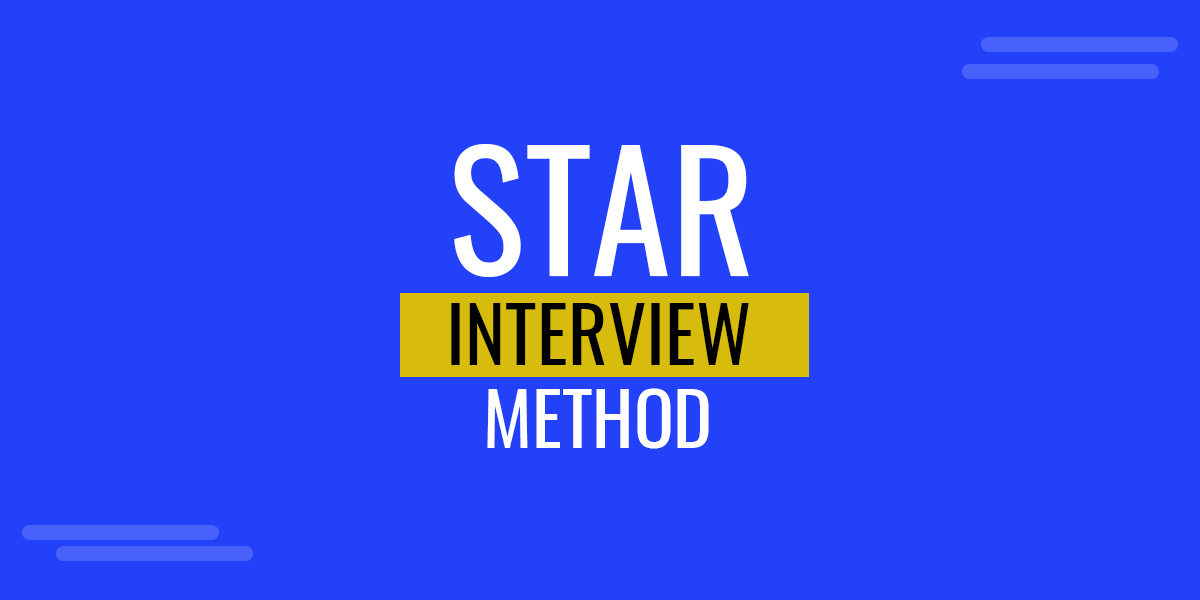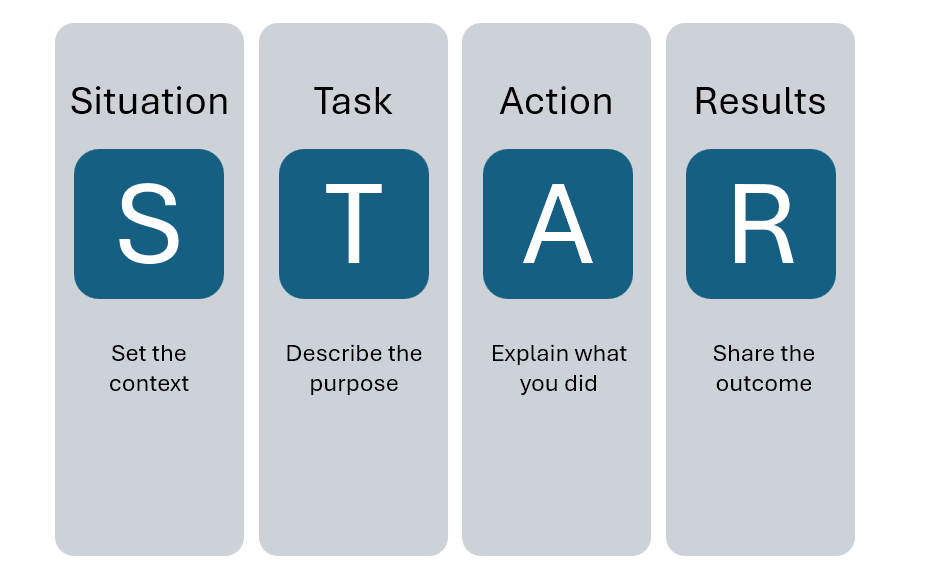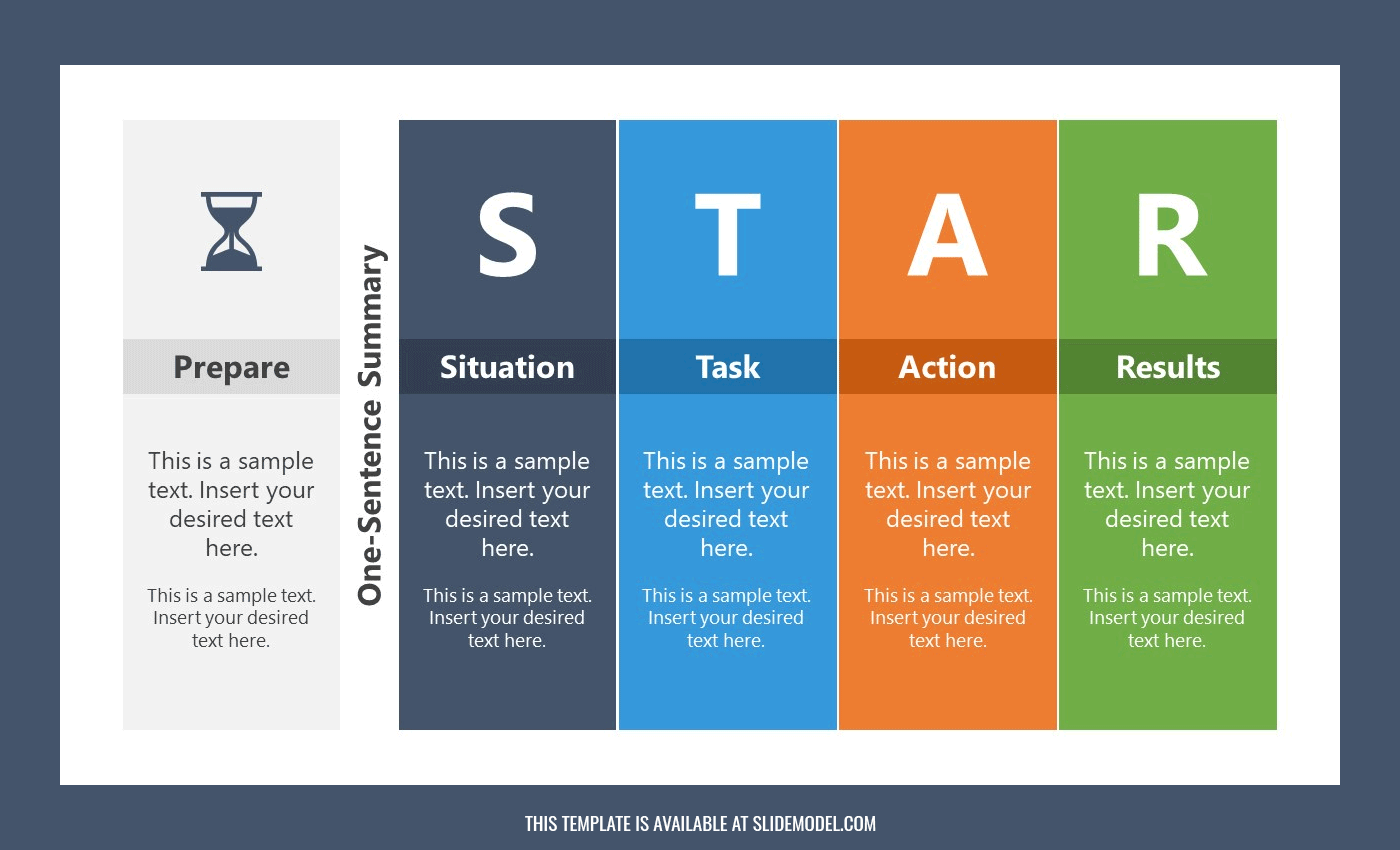STAR Interview Method: A Complete Guide for Acing the Behavioral Interviews
Last updated on April 1st, 2024

Interviewing is an integral part of the hiring and selection process of the potential candidates and is conducted to filter out the most suited and qualified employees for organizations. Employers use interviews as behavioral tests to analyze and evaluate the personal and professional skills and attributes of individuals applying for the open vacancies.
The personality of the candidate along with their psychological and technical aspects is judged and a final decision is made. The questions asked in the interviews can cause trouble for candidates sometimes and confuse them in many ways.
The STAR interview method provides a great way of tackling any kind of questions that may get asked during an interview. Candidates can easily ace any kind of interview and hiring process by mastering this process and applying its actionable strategies and techniques. This article is a complete guide to what a STAR Interview method actually is, its elements, and how it can be implemented by the candidates during their interviewing processes.
What is the STAR interview method?
The STAR interview method is a technique through which candidates can answer the questions asked by HR or management of any company effectively by understanding the behavioral aspects and telling relatable and convincing stories.
So a question may arise here: what does STAR stand for? STAR is actually the acronym for Situation, Task, Action, and Result.

Hence by understanding the different aspects in every question that may get asked by an interviewer, any candidate can handle the complex and tough questions being asked efficiently. These four elements of the STAR model for interview, with their significance, are described in detail as below.
Four basic elements of the STAR interview technique
STAR job interview technique mainly focuses on four basic elements. These elements are known as Situation, Task, Action, and Result. The STAR model for interview contains four key elements that are further described below.
Situation
While applying the STAR method during interviews, the first thing that you need to consider is the situation in which you may find yourself. Describe a situation related to the question and try to relate that situation with the core subject of the question being asked. Remember to relate the situation with the desired end result as well.
Task
In a specific situation, you may find yourself, you also need to describe the tasks and duties that were related to you and how you managed to perform these tasks as well. STAR format requires you to be as specific as possible about your duties in the situation being described.
Action
Now, it is time to tell how well you handled the situation. What were the actions performed by you? How did you provide a solution to the specific problem being faced? You don’t need to mention the activities and responsibilities of your team or a larger group in general. Try to specify your role in the actions being performed so that the interviewer can understand the initiatives and efforts that were related to your own personality and potential role.
Result
What was the end result of your actions during that specific situation? Did you achieve your desired objectives? How much impact did your efforts leave on the overall project’s success? An important point to remember while applying the STAR technique here is that you don’t need to be shy about taking the credit for your successful ventures and initiatives. If your actions brought some good actionable results, mention them as your rewards for efforts you made in that specific situation.
How to put the STAR Method in action for your interviews?
Using STAR format in your interviews is productive when you follow a proper process in order to decode the questions asked by HR or your interviewer. You can give impressive replies to them by using these simple steps.
1. Choose a suitable example
The beauty of the STAR Interview approach is that it allows you to become as creative as possible in a professional manner. Let’s say you are asked a question and you answer it effectively in a timely manner but by using a totally irrelevant example? Will it impress the employer? Absolutely, not. You need to design a relevant scenario for the question being asked and relate that scenario with it. You can use the storytelling technique in order to make your answer more interactive and appealing to the interviewer. It is also not possible that you can answer every type of question instantly by relating it to a possible situation. You can also ask for some time from the interviewer to think about a suitable example.
2. Design a relevant situation
The next step of the process is to support your arguments and ideas with the most supporting and convincing situation.
Here you don’t need to be too complex about a situation and then explain all the relevant factors attached to it. You need to paint a picture that is easy to understand and concise.
The purpose of using the STAR model here is to convince the interviewer about your role in a certain situation being described.
If the employer asks about a certain goal that you achieved previously, try to formulate and design a situation around your arguments that is credible, relevant, and easy to comprehend.
3. Mention the tasks
Once you have designed a situation, you need to describe the areas in which you may have played a certain role. Mention your duties and tasks in the particular situation that you have described earlier so that your interviewer can analyze where exactly your skills and expertise fit in.
These tasks are different from the actions and must not be confused with them as here, you will be just describing the certain duties, responsibilities, and tasks that were meant to be performed by you in a particular situation.
4. Describe your actionable steps and initiatives
At this stage, as the tasks that were ought to be performed by you have already been discussed, you need to mention how you tackled the situation with your actionable steps and initiatives. How did you resolve an issue practically? What were the measures considered by you while proceeding with the solution of a particular problem? This is where you actually shed more light on what exactly was done by you and how you contributed towards a project’s success. Mention any particular plans, softwares, techniques, or tools that were used by you during the project’s progress, if possible.
5. Mention the results
Now is the time to explain the results of your actions and strategies during the overall project’s progress.
- How did you add value to a certain project or process?
- What results were achieved?
- What were the tangible and intangible advantages of your initiatives?
This is the time when you convince your interviewer about how you left an impact on the overall project’s success.
The employers are actually looking to the final conclusions and results of your efforts. It may seem appealing to mention what you did and how you did it but the most underrated aspect that candidates usually forget is the mentioning of the results that were achieved through your actions. The interviewing business is looking forward to what exactly you can bring to the table. Mention the numbers, if possible. Ultimately, you will be needed to explain how your actions influenced the overall issue or problem and why your actions mattered in the end.
Making a job presentation taking advantage of STAR Interview methodology
Job presentations are usually required by the companies so that they can judge your communication, negotiation, and technical skills at the same time. You may need to prepare a slide presentation explaining the strengths and skills that are needed for a certain job role.
By using the STAR framework, you can format your job presentation effectively and influence your audience positively. You can shape the layout of your content and make decisive changes in your interview presentation so that you can easily handle any type of questions that may get asked during a job interview.
Many tools like PowerPoint and Google Slides and Keynote are widely used for designing and developing slide presentations. Fortunately, you don’t need to develop your presentation from scratch with an easy to handle and use interface of the PowerPoint software, which is the ultimate choice of almost 500 million active users. Our website Free PowerPoint Templates offers thousands of premade PowerPoint templates totally free of cost and you can download any template of your choice with a single click. By making some minor changes according to your customized needs, your own interview presentation will be ready in no time. If you need a specific PowerPoint template that focuses on the STAR interview method entirely, you can download this free STAR Interview PowerPoint template too.

Alternatively, if you are looking for a free STAR Interview Model Template, you can download our free STAR Interview PPT Template design.

Actionable Examples to answer interview questions using the STAR method
It is a lot easier to understand the STAR method interview questions and answers with some practical examples.
Example # 1
Let’s say an interviewer asks you about a situation where you disagreed with your manager. He asks you about how you managed to resolve that issue. Here is how you can answer this question by using the STAR methodology.
Situation
First of all, you need to describe the situation in which you happened to disagree with your manager. You need to specify your job duties and what the disagreement was all about. Then you need to mention some details why you disagreed with your manager. You can elaborate on the situation a bit more but try to make it more concise and understandable so that you maintain the interest of the interviewer during your conversation.
Task
Here, you need to mention your duties and responsibilities in that situation you just described. What were the tasks and duties relevant to you? Why were you involved in that disagreement? You need to mention the deliverables expected from you in that particular situation.
Action
Now, you need to tell exactly how you responded to the situation in which you found yourself. How did you disagree with your manager? What were the arguments and ideas that you used while going into a disagreement with your manager? You need to be clear about what exactly you did and you responded. This will paint a clear picture of your negotiation and communication skills in the mind of the employer.
Result
This is the last and more anticipated part of your conversation. You need to mention the results of your disagreement with your manager. How did it go? Did your manager appreciate your disagreement and value your suggestions? Were your arguments well-received? You need to sound as positive as possible here and try to mention the results in a positive way so that your interviewer can exactly see why he needs to hire you. It is highly favorable to describe the results that ultimately turned around to be in your favor.
Example # 2
For example, the interviewer asks you about the time when you had to work with other departments in order to complete a project. He asks you how managed to complete the project successfully? Here is how you will use the STAR process while answering.
Situation
In the first place, you need to describe the situation in which you have to work with the other departments in your company to proceed with a project. You can describe various departments involved in the project. You can mention your and your department’s role as well in the overall project’s success. Ultimately, you will be able to develop a relationship between the different departments involved to evaluate how their cooperation will lead to the ultimate success of the project.
Task
Now, you can explain the different tasks assigned to you and other departments as well. Be as specific as possible while mentioning the tasks. You need to define your job duties along with the responsibilities of other departments as well. You need to explain what exactly is required from all the stakeholders in the project’s progress.
Action
Here, you can explain the actions that were performed by you and your department along with the project’s progress. You also need to mention the role and contributions of the other departments as well during the business journey. Now, you are needed to mention the process by which you collaborated with other departments in order to reach a common goal. What strategies did you use to incorporate all the departments and their professionals in the project’s duration? What was your role in strengthening the team collaboration? How did you manage to complete the task in a timely manner?
Result
The ultimate goal of every project is to deliver some outcome in the end. You also need to describe how you managed to deliver the desired results along with the other departments in the end. Did you accomplish all of your set targets? If some of the objectives were not achieved, what was the reason behind it? Try to explain each and every outcome in a positive manner so that when you describe your role in the ultimate success of your project, your answers may sound appealing to the interviewer. You need to highlight your personal role in the overall project’s success and mention how you collaborated with other teams and managed to accomplish set targets with effective teamwork.
Summary
The STAR interview method is a methodology through which you try to ace your job interviews effectively by using a structured and well-defined approach. It is the acronym for Situation, Task, Action, and Result. By understanding these four elements and designing your answers by considering these parameters, almost all complex and tough interview questions can be answered effectively. When an interviewer asks a question, the first step is to design a situation around that question so that you can relate your answer by telling a story based on that situation. You need to mention the tasks relevant to you and how you performed some actions in order to complete those tasks. Ultimately, you will be required to offer an end result in a positive and appealing manner so that your interviewer can analyze your qualification and suitability for the job role you aspire for. The core purpose of using the STAR interview methodology is to influence the employers in a positive way so that the chances of you getting hired in all of your possible job hunting ventures brighten up.
We will send you our curated collections to your email weekly. No spam, promise!
